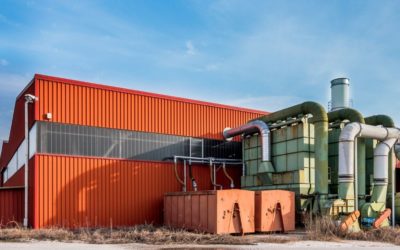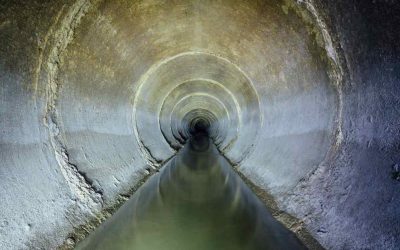Hydrogen Sulfide (H₂S) Remediation
Hydrogen Sulfide (H2S) is a colorless, toxic, highly flammable gas with a foul, pungent odor similar to that of rotten eggs odor at low concentrations and is not detectable by odor at high concentrations.
Often referred to as “sewer gas,” H2S is a result of the breakdown of organic matter by bacteria, typically in an oxygen deprived environment such as sewer systems or wastewater treatment plants.
H2S is a nuisance that can pose extreme safety hazards for personnel.
Chemical symbol: H2S
Specific Gravity: 1.192 (heavier than air)
Explosive limits: Lower: 4% , Upper: 44% volume in air
Ignition Temperature: 500o F
Solubility in water: 2.9 volumes of gas , per volume of water at 20o C
What Are The Effects of Hydrogen Sulfide?
Hydrogen Sulfide is an extremely toxic and irritating gas. Free hydrogen sulfide in the blood reduces its oxygen-carrying capacity, thereby depressing the nervous system. Hydrogen sulfide is oxidized quite rapidly to sulfates in the body, therefore no permanent aftereffects occur in cases of recovery from acute exposures unless oxygen deprivation of the nervous system is prolonged. There is no evidence that repeated exposures to hydrogen sulfide result in accumulative or systemic poisoning. Effects such as eye irritation, respiratory tract irritation, slow pulse rate, lassitude, digestive disturbances, and cold sweats may occur but these symptoms disappear in a relatively short time after removal from the exposure.
Odors become detectable in concentrations as low as .008 parts per million (ppm)
but the sense of smell is lost after 2-15 minutes at 100 ppm.
Physiological response:
|
10 ppm |
Beginning eye irritation |
|
50-100 ppm |
Slight conjunctivitis and respiratory tract irritation after 1 hour exposure |
|
100 ppm |
Coughing, eye irritation, loss of sense of smell after 2-15 minutes. Altered respiration, pain in the eyes and drowsiness after 15-30 minutes followed by throat irritation after 1 hour. Several hours exposure results in gradual increase in severity of these symptoms and death may occur within the next 48 hours. |
|
200-300 ppm |
Marked conjunctivitis and respiratory tract irritation after 1 hour of exposure |
|
500-700 ppm |
Loss of consciousness and possibly death in 30 minutes to 1 hour. |
|
700-1000 ppm |
Rapid unconsciousness, cessation of respiration and death. |
|
1000-2000 ppm |
Unconsciousness at once, with early cessation of respiration and death in a few minutes. Death may occur even if individual is removed to fresh air at once. |
To avoid discomfort, the (8 hour) time weighted average concentration of hydrogen sulfide shall not exceed 10 ppm.
This information excerpted from the American National Standards Institute standard: Z37.2-1972 Acceptable Concentrations of Hydrogen Sulfide.
Click the Green Button to Get a Printable Version
Case Studies and Articles
Hydrogen Sulfide Treatment in a Wastewater Collection System
Collection System 0.2 MGD Wastewater collection systems are prone to accumulate high hydrogen sulfide (H2S) concentrations. Sulfatereducing bacteria (SRB) produce H2S in these systems inthe process of breaking down organic compounds under anaerobic conditions.1...
H₂S Reduction in an AIRVAC Sewer System Force Main
Collection System 0.02 MGD Sewer systems are prone to accumulate hydrogen sulfide (H2S) gas. This compound is produced by sulfate reducing bacteria (SRB) in the process of metabolizing organic matter under anaerobic conditions.1 Substantial quantities of H2S can be...
Bioaugmentation Reduces H₂S in a Collection System
Collection System 0.005 MGD Hydrogen sulfide (H2S) gas commonly accumulates in collection systems causing issues for wastewater utilities. This compound is produced when sulfate reducing bacteria (SRB) break down organic material under anaerobic conditions.1 H2S has...
Treating H₂S in a Collection System with Bioaugmentation
Collection System 0.04 MGD Hydrogen sulfide (H2S) is a noxious gas that can accumulate in collection systems. This gas forms when sulfate reducing bacteria (SRB) digest organic material under anaerobic conditions.1 Furthermore, H2S production is a prominent issue for...
How to Control H₂S Corrosion
ProBiotic Scrubber® OCC Is The Solution For Reducing H₂S Corrosion At BioLynceus®, our team is constantly striving to enhance our product line. Recently, this effort has developed ProBiotic Scrubber® OCC to eliminate the production of hydrogen sulfide and sulfuric...
How to Treat and Remove H₂S Odor
You can remove H2S odor quickly and easily with ProBiotic Scrubber OCC.







